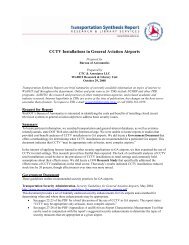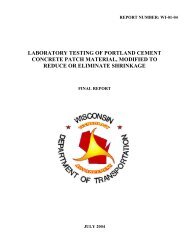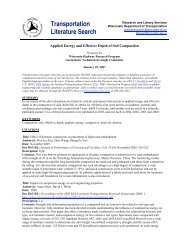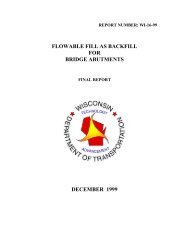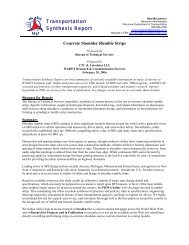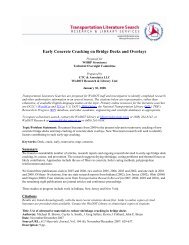Improved Life for Longitudinal Joints in Asphalt Pavement - WisDOT ...
Improved Life for Longitudinal Joints in Asphalt Pavement - WisDOT ...
Improved Life for Longitudinal Joints in Asphalt Pavement - WisDOT ...
You also want an ePaper? Increase the reach of your titles
YUMPU automatically turns print PDFs into web optimized ePapers that Google loves.
<strong>WisDOT</strong> ApproachThe current <strong>WisDOT</strong> design of longitud<strong>in</strong>al jo<strong>in</strong>ts <strong>in</strong> asphalt pavement is a “Michigan jo<strong>in</strong>t” or “wedge jo<strong>in</strong>t”design. It features a ½-<strong>in</strong>ch notch at the top of the jo<strong>in</strong>t, a vertical drop perpendicular to the lane surface, and a 12:1tapered slope <strong>in</strong>to the space where the next lane will be laid. This jo<strong>in</strong>t is treated with a tack coat and the next layeris rolled over the jo<strong>in</strong>t slope. If the jo<strong>in</strong>t is cold, it is heated and tacked and the next lane is placed. See <strong>WisDOT</strong>Standard Specifications, Sections 450.3.2.5(6) and 450.3.2.8, athttp://roadwaystandards.dot.wi.gov/standards/stndspec/sect450.pdf (pages 5 to 6 of the PDF). For a draw<strong>in</strong>g, see the<strong>WisDOT</strong> Facilities Development Manual, Chapter 14, Procedure 14-10-5, Figure 5, athttp://roadwaystandards.dot.wi.gov/standards/fdm/14/FDM14.pdf (page 29 of the PDF).Jo<strong>in</strong>t DesignThe Michigan or tapered jo<strong>in</strong>t became the standard <strong>in</strong> the 1990s. A variety of publications have spun off NCATReport No. 97-4, published <strong>in</strong> 1997, which <strong>for</strong>mally established the effectiveness of the tapered or notched jo<strong>in</strong>t.National Center <strong>for</strong> <strong>Asphalt</strong> Technology. S<strong>in</strong>ce at least the late 1990s, the Michigan or tapered jo<strong>in</strong>t design hasbeen considered the best option <strong>for</strong> longitud<strong>in</strong>al jo<strong>in</strong>ts <strong>in</strong> asphalt pavements and asphalt overlays. An NCAT studycompared jo<strong>in</strong>ts <strong>in</strong> Michigan, Wiscons<strong>in</strong>, Colorado and Pennsylvania, and the results led to a number of later articlesand studies. These <strong>in</strong>clude:• <strong>Longitud<strong>in</strong>al</strong> Jo<strong>in</strong>t Construction Techniques <strong>for</strong> <strong>Asphalt</strong> <strong>Pavement</strong>s, Prithvi Kandhal and Rajib Mallick,NCAT Report No. 97-4, August 1997.http://ntl.bts.gov/lib/7000/7900/7944/rep97-4.pdfThis project studied 30 designs <strong>in</strong> four states. The best-per<strong>for</strong>m<strong>in</strong>g jo<strong>in</strong>t after four years was a Michiganjo<strong>in</strong>t that featured a 12.5-mm vertical offset and a 12:1 taper.• A 2007 NCAT PowerPo<strong>in</strong>t presentation <strong>in</strong>cludes material from the 1997 study (seehttp://www.ucs.iastate.edu/mnet/_repository/2007/asphalt/pdf/practices%20and%20specifications%20<strong>for</strong>%20longitud<strong>in</strong>al%20jo<strong>in</strong>ts%20-%20prowell.pdf). The presentation discusses measur<strong>in</strong>g per<strong>for</strong>mance at thetime of construction, describes German methods, and presents four states’ specifications. Best-per<strong>for</strong>m<strong>in</strong>gmethods <strong>for</strong> construction <strong>in</strong>clude:o Use of rubberized jo<strong>in</strong>t adhesiveo Notched-wedge design, with a 12:1 taper over 12 <strong>in</strong>ches, and a notch of 0.5 to 0.75 <strong>in</strong>cheso Use of cutt<strong>in</strong>g wheel and edge-restra<strong>in</strong><strong>in</strong>g deviceo Roll<strong>in</strong>g from hot side with 6-<strong>in</strong>ch overlap• A PowerPo<strong>in</strong>t presentation on the NCAT data confirms the Michigan jo<strong>in</strong>t’s effectiveness, and notesseveral factors <strong>in</strong> effective jo<strong>in</strong>t construction (seehttp://www.asphaltalliance.com/upload/<strong>Longitud<strong>in</strong>al</strong>%20<strong>Jo<strong>in</strong>ts</strong>%20-%20Ray%20Brown.pdf). Conclusions<strong>in</strong>clude:o Vertical offsets are essential.o Rubberized jo<strong>in</strong>t adhesive is effective.o Roll<strong>in</strong>g should be conducted as soon as possible.o The jo<strong>in</strong>t can be compacted to a density with<strong>in</strong> 2 percent of the mat density.• See also “Study of <strong>Longitud<strong>in</strong>al</strong>-Jo<strong>in</strong>t Construction Techniques <strong>in</strong> Hot-Mix <strong>Asphalt</strong> <strong>Pavement</strong>s,” PrithviKandhal and Rajib Mallick, Transportation Research Record No. 1543, 1996: 106-112. (See attached file.)• The “New Jersey” jo<strong>in</strong>t, one of the other designs tried and found less effective, is a 3:1 wedge without anotch at the unconf<strong>in</strong>ed edge of the first lane that is heated be<strong>for</strong>e the next lane is placed.• “<strong>Asphalt</strong> Answers,” Roads and Bridges Magaz<strong>in</strong>e, January 1998.http://www.roadsbridges.com/ASPHALT-ANSWERS-article973Kandhal writes that after five years, the Michigan jo<strong>in</strong>t rema<strong>in</strong>s the most promis<strong>in</strong>g design.TRB“Evaluation of Notched-Wedge <strong>Longitud<strong>in</strong>al</strong> Jo<strong>in</strong>t Construction,” M. Shane Buchanan, Transportation ResearchRecord No. 1712, 2000: 50-57. (See attached file.)This paper, from the 2000 TRB Annual Meet<strong>in</strong>g, follows up on notched-wedge jo<strong>in</strong>ts <strong>in</strong> Alabama, Colorado,Indiana, Maryland and Wiscons<strong>in</strong>, and f<strong>in</strong>ds from cores that they’ve been per<strong>for</strong>m<strong>in</strong>g well <strong>in</strong> terms of density at thelongitud<strong>in</strong>al jo<strong>in</strong>t.2



